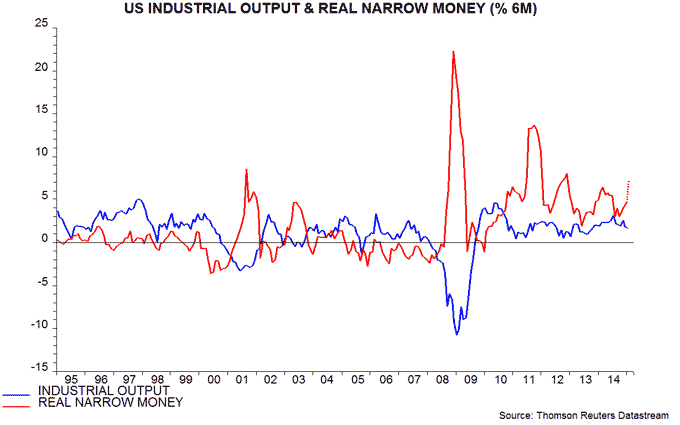A post in September noted that US narrow money growth had fallen sharply and was signalling a loss of economic momentum in early 2015, allowing for the usual lag. US economic news has mostly disappointed recently, reflected in a significant negative reading of the Citigroup US data surprise index, while the Atlanta Fed’s “nowcast” model suggests GDP growth in the first quarter of only 1.2% annualised.
The slowdown predicted by monetary trends has been magnified by cuts in oil and gas extraction-related investment and employment. New advertisements for extraction jobs and related high-education occupations plunged by 42% and 38% respectively between November and January, according to the Conference Board.
Some commentators claim that economic weakness will be sustained through 2015, with familiar voices even suggesting that a recession is looming. This is not the message from the latest monetary trends.
As discussed in a post in January, six-month growth of US real (i.e. inflation-adjusted) narrow money recovered at end-2014, reflecting an energy-driven fall in consumer prices. The revival continued in January and available weekly data for February suggest a further large gain, this time driven by stronger nominal expansion – see chart*.
Broader money measures have also reaccelerated. Based on the weekly data, six-month growth of real M2 probably rose to 4.0% in February, or 8.1% annualised – the highest since December 2011.
Monetary trends, therefore, suggest that current economic weakness will extend into the second quarter but growth will bounce back strongly in the second half of 2015.
Previous posts (e.g. here) noted that 10 of the 11 US recessions since World War Two were preceded by a contraction of real narrow money, the exception being 1953-54 downturn, which may have been caused by fiscal tightening as defence spending was slashed after the Korean War. A 2015 recession remains unlikely, with the latest monetary trends suggesting a receding risk.
*The February estimate is based on the average level of narrow money through 23 February and an assumed 0.4% monthly increase in consumer prices.